Every writer knows the feeling of staring at a blank page, unsure where to begin. The possibilities are endless, after all. And in all the excitement of researching unique, inspired angles, it’s easy to veer off course or spend hours on research you end up not using.
Thankfully, AI content briefs can help cut content creation time without compromising quality. They automate the groundwork by analyzing top-performing articles, extracting key insights, and building logical outlines packed with relevant keywords and proven content structures.
With AI handling the initial research and organization, writers can focus more on weaving compelling narratives that resonate with readers and less on sifting through SERPs. Here’s everything you need to know about AI content briefs, including how they work, which tools stand out, and how to use them to streamline your writing process.
How Effective Are AI Content Briefs?
Writing is fundamentally creative, but it’s not without repetitive tasks that can eat up your time. Think about how much time you spend researching before writing. Reading competitor articles, noting key points, organizing ideas, picking headlines—it all adds up.
AI content briefs handle these tasks in minutes, freeing you to focus on what matters: creating stellar marketing content that resonates and offers value. When you’re targeting a specific keyword, for instance, AI analyzes top-ranking articles to show you:
- Topics your readers expect to see
- Questions they’re asking
- Key statistics and data points
- Content gaps you can fill
- Internal linking opportunities
- Structure that works for both readers and search engines
This means you no longer have to choose between writing for SEO purposes and writing for your audience. You can do both—without the guesswork.
AI content briefs also help you work smarter. They can build topical maps, suggest keywords for internal linking, and spot gaps in your competitors’ content. These features go beyond saving time to give your content a competitive edge.
How to Create an AI Content Brief
A solid content brief centers on two core elements: purpose and audience.
- Purpose: What’s the overarching goal of your article? Are you informing, guiding, or persuading your readers?
- Audience: Who exactly are you writing for? Search engines like Google prioritize content that delivers real value to its audience.
AI content brief tools are designed specifically with these elements in mind. To put things into practice, let’s see how you can create an AI content brief using Frase.
Using Frase to Generate AI Content Briefs
From Frase’s homepage, select the Outline Generator tool as shown below.
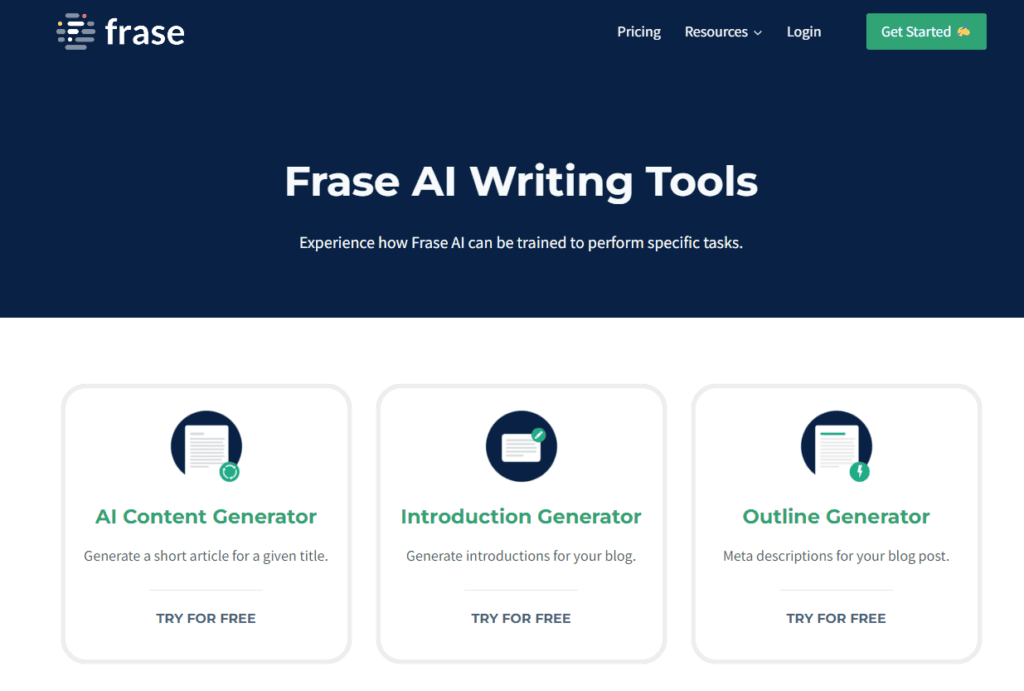
Next, enter your article title and a short description, along with any keywords you want to target. Then, hit the generate button, and let Frase AI work its magic. Within seconds, you’ll get suggested headings and a detailed structure for your article.
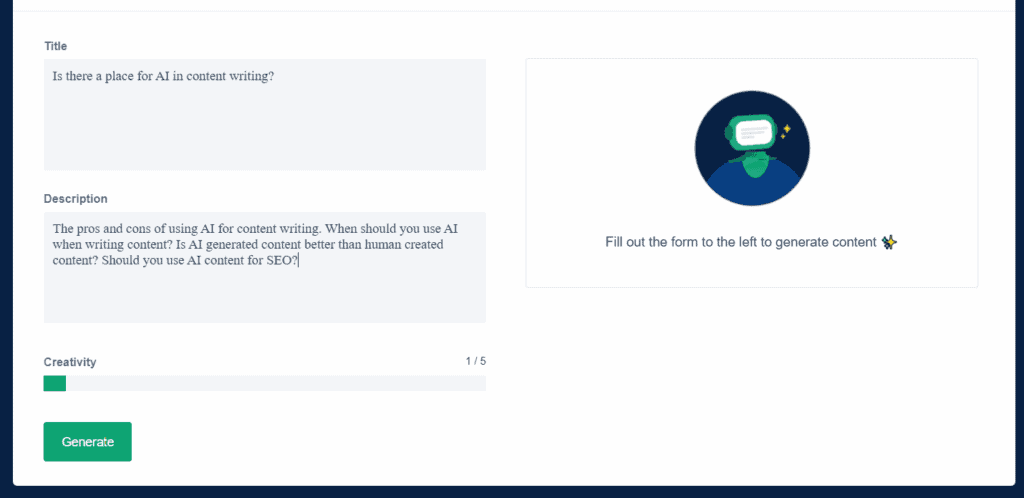
Once generated, you can edit the brief to include formatting suggestions (like H tags, bullet points, or numbered lists), source articles, and recommended links. This step keeps the brief perfectly aligned with your goals for the article.
3 Leading Tools for Creating AI Content Briefs
Ready to speed up your writing process without sacrificing quality? Here are three of the best AI content brief tools to consider, depending on your budget, needs, and goals.
SurferSEO
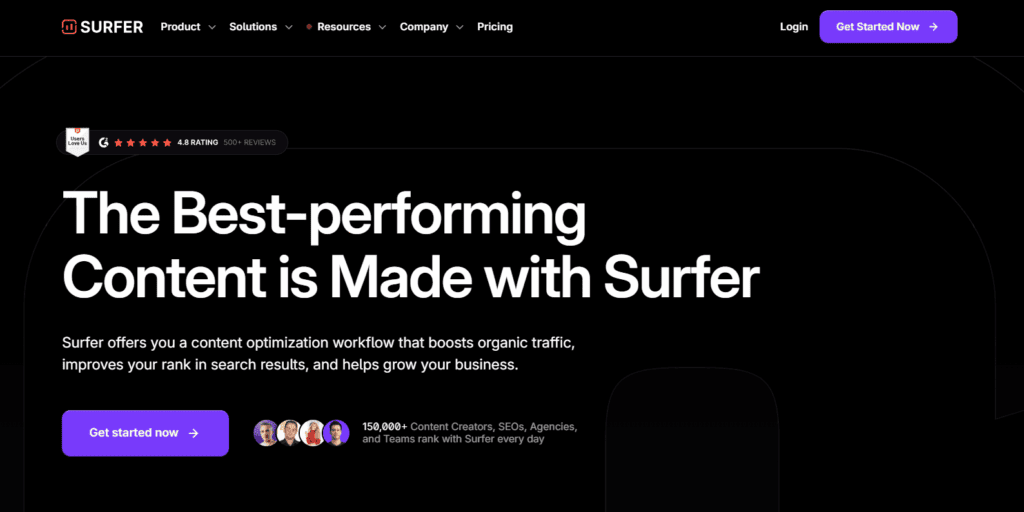
G2 Rating: 4.8/5 ⭐ from 531 reviews
SurferSEO makes writing for SEO purposes a breeze by analyzing top-ranking pages for your target keyword. It examines headings, keywords, images, and word count, then crafts a detailed brief to help you create better, more competitive content.
But it doesn’t stop there. SurferSEO also features an AI writing assistant and a content-scoring tool, giving you real-time feedback on optimization as you write.
Pricing
- Essential: $99/month (30 articles per month)
- Scale: $219/month (100 articles/month)
- Enterprise: Custom pricing
- 7-day money-back guarantee
Frase
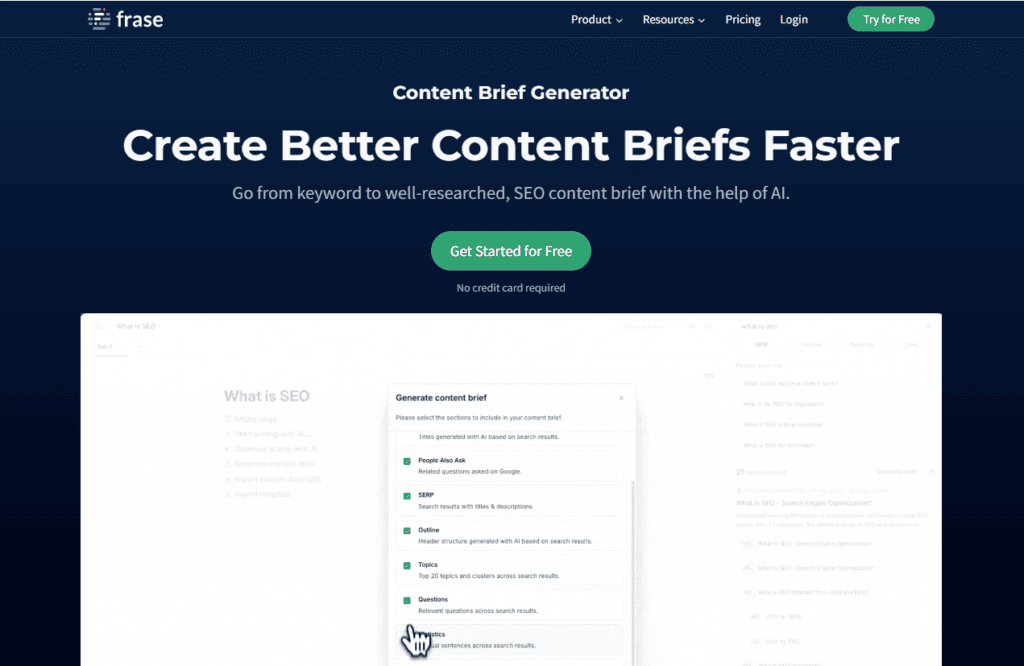
G2 Rating: 4.8/5 ⭐ from 296 reviews
Frase is a versatile tool that lets you create content briefs, write full articles, or paraphrase existing text. It stands out for its simplicity and flexibility, catering to solo writers and content teams alike.
To generate a content brief using Frase, simply enter a title and a short description. Frase will then suggest headings, a conclusion, and a structure for your article. It’s a great option if you want a quick starting point for your content without spending hours on research.
Pricing
- Free Trial: One SEO document per month.
- Basic: $45/month—Great for growing content needs (30 SEO documents).
- Team: $115/month—Unlimited SEO documents for teams.
- Enterprise: Custom pricing
GrowthBar
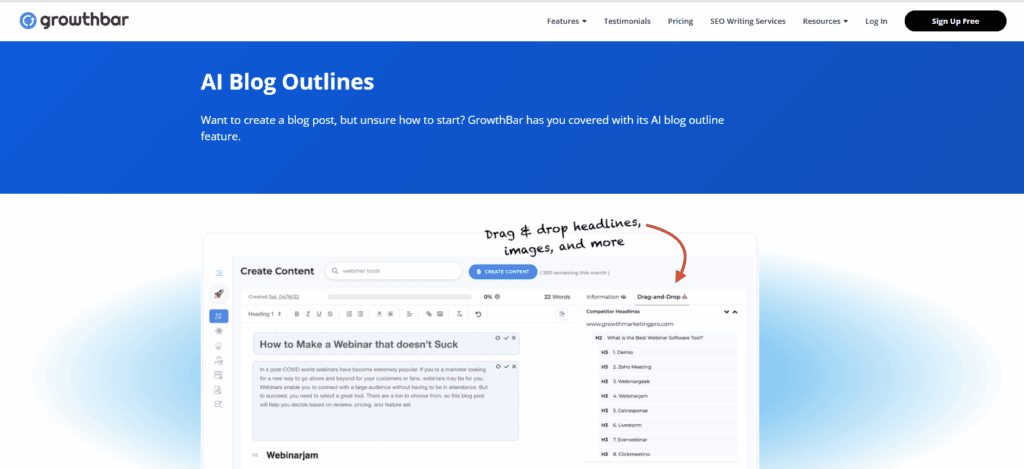
G2 Rating: 4.8/5 ⭐ from 33 reviews
GrowthBar makes it easy to create content briefs with just a keyword. It pulls heading ideas and FAQs from SERP results, so you know exactly what your audience is searching for.
You can also drag and drop to reorder sections, and it’ll suggest word count, headings, images, links, and even readability levels to aim for.
What’s more, GrowthBar comes with extras like keyword research, competitor analysis, and Google Search Console integration—making it an all-in-one SEO content powerhouse.
Pricing
- 7-Day Free Trial—Test out the features risk-free.
- Standard: $36/month—Solid for freelancers and small teams.
- Pro: $74.25/month—Ideal for growing businesses.
- Agency: $149.25/month—Best for larger teams and agencies.
Common Pitfalls of Using AI to Generate Content Briefs
AI content briefs are undoubtedly useful for speeding up the writing process. But they’re not perfect. And without human input, they’re likely to result in poor content quality and effectiveness. Here are the key pitfalls to watch out for:
- Overreliance on AI: While AI can organize and optimize content based on SERP data, it lacks the strategic insight that experienced SEO companies and editors bring. So, before publishing, always have a professional review your briefs for clarity, purpose, and tone.
- Lack of Originality: AI tools often analyze top-performing pages and find common patterns, which can lead to generic content that lacks originality. To stand out, writers and editors must add unique perspectives or fresh insights.
- Inconsistent Brand Messaging: AI-generated briefs might not always capture your brand’s voice, tone, or messaging nuances. Although you can train AI to recognize certain patterns, a human touch is still necessary to make sure the brief reflects your brand’s voice and values.
Key Takeaways
AI content briefs are a powerful tool for streamlining content production. They save writers hours of research and automatically optimize drafts for SEO. For the best results, keep these tips in mind:
- Start with AI, but don’t stop there: Use AI-generated briefs as a foundation, but always review and refine them with human insight.
- Prioritize originality: Add your fresh, unique perspective to avoid generic content.
- Optimize for brand consistency: Double-check that the brief aligns with your brand’s messaging, tone, and style.
- Prioritize value: Ensure every brief provides clear value to your audience, not just search engines.






